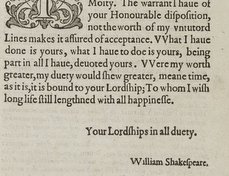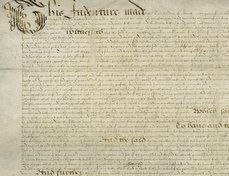Reproduced by permission of Shakespeare Birthplace Trust
Terms of use
The Shakespeare Birthplace Trust has graciously contributed images under a Creative Commons Attribution NonCommerical ShareAlike 4.0 International license. Visitors may download, link to and cite the images for personal research only. Any further use, including, but not limited to, unauthorized downloading or distribution of the images, commercial or third party use, is strictly prohibited. Visitors must contact the Shakespeare Birthplace Trust to request additional use, at: images.scla@shakespeare.org.uk
Document-specific information
Title: Shakespeare's Birthplace: documents of title
Date: Michaelmas Term 1647
Repository: The Shakespeare Birthplace Trust, Stratford-upon-Avon, UK
Call number and opening: TR46/1/10
View online bibliographic record
Robert Bearman, "Susanna Hall and her daughter Elizabeth Nash settle the estates inherited from William Shakespeare: the 'recovery'," Shakespeare Documented, https://doi.org/10.37078/726.
Shakespeare Birthplace Trust, TR46/1/10. See Shakespeare Documented, https://doi.org/10.37078/726.
Thomas Nash, first husband of Elizabeth Hall, Shakespeare’s granddaughter, died on April 4, 1647 without issue. Under his will, he left New Place, the four and a half yardlands in Old Stratford, and the Blackfriars Gatehouse directly to his kinsman, Edward Nash, with no regard to the interests of his mother-in-law and wife, still only thirty-nine, as provided for under the settlement of the Shakespeare estate, dated May 27, 1639. Within a week or two of Nash’s death, Susanna and Elizabeth therefore set in motion proceedings to secure a new settlement.
After arranging for the estate to pass to trustees and the conditions of a new settlement agreed the “recovery” of the estate for the purposes stipulated was formally ratified in the Court of Common Pleas in the following Michaelmas Term, as recorded in the standard (but elaborately illuminated) document shown here in which the property was again described in purely formulaic terms, as it had been in the final concord which had initiated the process.
Edward Nash disputed the maneuver and filed a bill in Chancery in February 1648 seeking to compel Susanna and Elizabeth to implement the provisions of Thomas Nash’s will. Proceedings petered out towards the end of 1650, that is, after Susanna’s death, with no formal decree issued to settle the dispute. Some compromise may have been agreed, reflected in a provision of Elizabeth Nash’s will (by then Lady Barnard) whereby Edward Nash was given the opportunity to acquire New Place and the four and half yardlands “according to my promise formerly made to him.”
Written by Robert Bearman
Last updated May 21, 2020



















